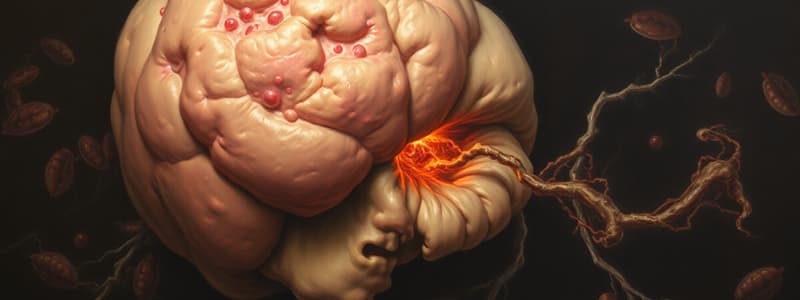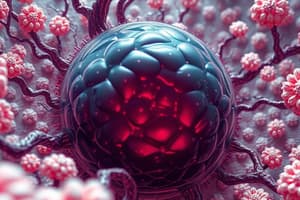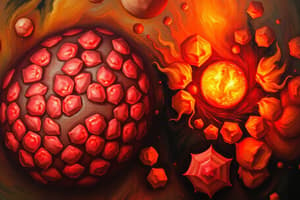Podcast
Questions and Answers
What is the initial requirement for tumor cells to initiate metastasis?
What is the initial requirement for tumor cells to initiate metastasis?
- Direct dissemination through a body cavity.
- Ability to induce angiogenesis in distant tissues.
- Escape from the primary tumor mass. (correct)
- Increased expression of adhesion molecules.
Which of the following mechanisms is primarily responsible for cancer-related deaths?
Which of the following mechanisms is primarily responsible for cancer-related deaths?
- Uncontrolled primary tumor growth.
- Local tissue invasion.
- Angiogenesis within the primary tumor.
- Metastasis to vital organs. (correct)
What cellular process is directly inhibited by the loss of cadherins in tumor cells during metastasis?
What cellular process is directly inhibited by the loss of cadherins in tumor cells during metastasis?
- Adhesion. (correct)
- Migration.
- Proliferation.
- Invasion.
Which of the following is a critical step for tumor cells during the process of extravasation?
Which of the following is a critical step for tumor cells during the process of extravasation?
How do platelets contribute to the metastatic process?
How do platelets contribute to the metastatic process?
What is the significance of tumor cells establishing contacts with ECM elements in the tumor stroma?
What is the significance of tumor cells establishing contacts with ECM elements in the tumor stroma?
What is meant by the term "carcinomatosis"?
What is meant by the term "carcinomatosis"?
Under what circumstance can regional lymph nodes be bypassed in the metastatic process?
Under what circumstance can regional lymph nodes be bypassed in the metastatic process?
What characteristic makes veins more susceptible to tumor invasion compared to arteries?
What characteristic makes veins more susceptible to tumor invasion compared to arteries?
Which of the following best describes transcoelomic spread?
Which of the following best describes transcoelomic spread?
What is a key characteristic of tumors that are isolated from multiple animals affected by Devil Facial Tumor Disease (DFTD)?
What is a key characteristic of tumors that are isolated from multiple animals affected by Devil Facial Tumor Disease (DFTD)?
Which of the following is an example of a transmissible tumor?
Which of the following is an example of a transmissible tumor?
What is the primary difference between heritable and somatic mutations in the context of cancer development?
What is the primary difference between heritable and somatic mutations in the context of cancer development?
Which of the following best characterizes cancer development at the genetic level?
Which of the following best characterizes cancer development at the genetic level?
Which event is most associated with the activation of oncogenes in cancer cells?
Which event is most associated with the activation of oncogenes in cancer cells?
What distinguishes germline mutations from somatic mutations in the context of cancer genetics?
What distinguishes germline mutations from somatic mutations in the context of cancer genetics?
What is meant by the term 'cancer syndrome'?
What is meant by the term 'cancer syndrome'?
How do somatic mutations contribute to the increased risk of cancer with age?
How do somatic mutations contribute to the increased risk of cancer with age?
Which of the following describes the term 'epigenetic' in the context of cancer?
Which of the following describes the term 'epigenetic' in the context of cancer?
What is a common epigenetic modification observed in cancer cells, as opposed to normal cells?
What is a common epigenetic modification observed in cancer cells, as opposed to normal cells?
How does histone acetylation affect chromatin configuration and gene transcription?
How does histone acetylation affect chromatin configuration and gene transcription?
Which of the following is the most accurate description of proto-oncogenes?
Which of the following is the most accurate description of proto-oncogenes?
What happens when a proto-oncogene is 'activated'?
What happens when a proto-oncogene is 'activated'?
How does a mutation in the RAS protein contribute to cancer development?
How does a mutation in the RAS protein contribute to cancer development?
What is the function of tumor suppressor genes?
What is the function of tumor suppressor genes?
Which hypothesis explains that both alleles of a tumor suppressor gene must be inactivated for cancer to develop?
Which hypothesis explains that both alleles of a tumor suppressor gene must be inactivated for cancer to develop?
What does the term 'haploinsufficiency' mean in the context of tumor suppressor genes?
What does the term 'haploinsufficiency' mean in the context of tumor suppressor genes?
What role does the p53 protein play in preventing cancer development?
What role does the p53 protein play in preventing cancer development?
What is an initiating event in the progression of colorectal cancer, according to the multistage carcinogenesis model?
What is an initiating event in the progression of colorectal cancer, according to the multistage carcinogenesis model?
How are direct-acting chemical carcinogens different from indirect-acting chemical carcinogens?
How are direct-acting chemical carcinogens different from indirect-acting chemical carcinogens?
What type of damage is primarily caused by ionizing radiation to DNA?
What type of damage is primarily caused by ionizing radiation to DNA?
What is the significance of radiation being classified as a 'complete carcinogen'?
What is the significance of radiation being classified as a 'complete carcinogen'?
What is a key distinction between grading and staging in cancer diagnosis?
What is a key distinction between grading and staging in cancer diagnosis?
What does the 'T' in the TNM staging system refer to?
What does the 'T' in the TNM staging system refer to?
In the TNM staging system, what does a higher 'N' value (e.g., N3) typically indicate?
In the TNM staging system, what does a higher 'N' value (e.g., N3) typically indicate?
In the TNM staging system, what does 'M0' indicate?
In the TNM staging system, what does 'M0' indicate?
What role do integrins play in the context of tumor cell adhesion during metastasis?
What role do integrins play in the context of tumor cell adhesion during metastasis?
What is the primary mechanism by which tumor cells actively migrate during the metastatic process?
What is the primary mechanism by which tumor cells actively migrate during the metastatic process?
How do matrix metalloproteinases (MMPs) contribute to stromal invasion by tumor cells?
How do matrix metalloproteinases (MMPs) contribute to stromal invasion by tumor cells?
What is the significance of chemotactic factors in the process of intravasation?
What is the significance of chemotactic factors in the process of intravasation?
What is the role of shared adhesion molecules in the formation of tumor emboli?
What is the role of shared adhesion molecules in the formation of tumor emboli?
What determines the site of tumor cell extravasation during metastasis?
What determines the site of tumor cell extravasation during metastasis?
Why are veins, in general, more prone to tumor invasion compared to arteries?
Why are veins, in general, more prone to tumor invasion compared to arteries?
How does DNA methylation influence gene expression in cancer cells?
How does DNA methylation influence gene expression in cancer cells?
How do oncogenes disrupt normal cellular function to promote cancer development?
How do oncogenes disrupt normal cellular function to promote cancer development?
In the context of tumor suppressor genes, what does Knudson's "two-hit" hypothesis propose?
In the context of tumor suppressor genes, what does Knudson's "two-hit" hypothesis propose?
Flashcards
Tumor Dissemination
Tumor Dissemination
The process by which a local tumor spreads to other sites within the body.
Mechanisms of Tumor Invasion and Metastasis
Mechanisms of Tumor Invasion and Metastasis
Each of the series of events that occur during tumor invasion and metastasis, in order.
Adhesion in Tumor Metastasis
Adhesion in Tumor Metastasis
Detachment of tumor cells with penetration of the basement membrane, and entering of the ECM.
Migration in Tumor Metastasis
Migration in Tumor Metastasis
Signup and view all the flashcards
Stromal Invasion
Stromal Invasion
Signup and view all the flashcards
Intravasation
Intravasation
Signup and view all the flashcards
Tumor Emboli
Tumor Emboli
Signup and view all the flashcards
Extravasation
Extravasation
Signup and view all the flashcards
Lymphatic Spread
Lymphatic Spread
Signup and view all the flashcards
Hematogenous Spread
Hematogenous Spread
Signup and view all the flashcards
Transcoelomic Spread
Transcoelomic Spread
Signup and view all the flashcards
Transmissible Tumors
Transmissible Tumors
Signup and view all the flashcards
Heritable Alterations in Cancer
Heritable Alterations in Cancer
Signup and view all the flashcards
Point Mutations
Point Mutations
Signup and view all the flashcards
DNA Strand Breaks
DNA Strand Breaks
Signup and view all the flashcards
Insertions and Deletions
Insertions and Deletions
Signup and view all the flashcards
Amplifications
Amplifications
Signup and view all the flashcards
Aneuploidy
Aneuploidy
Signup and view all the flashcards
Germline Mutations
Germline Mutations
Signup and view all the flashcards
Acquired Somatic Mutations
Acquired Somatic Mutations
Signup and view all the flashcards
Epigenetic
Epigenetic
Signup and view all the flashcards
DNA Methylation
DNA Methylation
Signup and view all the flashcards
Molecular Determinants of Cancer
Molecular Determinants of Cancer
Signup and view all the flashcards
Proto-oncogenes
Proto-oncogenes
Signup and view all the flashcards
Tumor Suppressor Genes
Tumor Suppressor Genes
Signup and view all the flashcards
Haploinsufficiency
Haploinsufficiency
Signup and view all the flashcards
Multistage Carcinogenesis
Multistage Carcinogenesis
Signup and view all the flashcards
Mutagens
Mutagens
Signup and view all the flashcards
Carcinogens
Carcinogens
Signup and view all the flashcards
Oncogenic Viruses
Oncogenic Viruses
Signup and view all the flashcards
Cancer Prognosis
Cancer Prognosis
Signup and view all the flashcards
Histopathologic Diagnosis
Histopathologic Diagnosis
Signup and view all the flashcards
Grade of Tumor
Grade of Tumor
Signup and view all the flashcards
Tumor Stage
Tumor Stage
Signup and view all the flashcards
TNM System
TNM System
Signup and view all the flashcards
Study Notes
Tumor Dissemination
- Local tumors spread to other sites, aided by genetic and epigenetic changes that promote metastasis.
- Tumor cells must break free of the primary mass via loss of adhesion and acquire migratory capabilities.
- Immune evasion is crucial for tumor cells.
- Cells must exit vessels and integrate into new tissue.
- Metastasis accounts for much cancer-related mortality.
- Can occur through lymphatic vessels, blood vessels, or direct dissemination.
Mechanisms of Tumor Invasion and Metastasis
- A series of events is required for tumor invasion and metastasis.
- These events include adhesion, migration, stromal invasion, intravasation, tumor emboli formation and extravasation.
Step 1: Adhesion
- Detachment of tumor cells occurs with penetration of the basement membrane, and entering of the ECM.
- The dismantling of intercellular adhesion structures requires requires loss of cadherins and catenins.
- Contacts are established with ECM elements within the tumor stroma.
- Integrins and other specific receptors on tumor cell membranes recognize and bind to fibronectin, laminin, collagen, and vitronectin.
- Carcinoma cells often express increased numbers of these receptors during invasion and metastasis.
Step 2: Migration
- Tumor cells migrate actively.
- Alterations in the cytoskeleton and the cellular adhesion structures mediate migration.
- Autocrine growth factors (hepatocyte growth factor or scatter factor) stimulate migration.
- Cleavage products of ECM components, including fragments of collagen also stimulate migration.
Step 3: Stromal Invasion
- Involves penetrating the basement membrane and invading surrounding tissue.
- Proteases and antiproteases produced/activated by the tumor cells play a role.
- Tumor promoting proteases include matrix metalloproteinases (type IV collagenases) and urokinase (a serine protease).
Step 4: Intravasation
- The invasion of blood or lymphatic vessels by cancer cells.
- Involves the penetration of endothelial basement membranes, cells pass between or through endothelial cells into the vessel lumen.
- Chemotactic factors produced by multiple cell types attract vessels.
Step 5: Tumor Emboli
- Once inside a lymphatic or blood vessel, tumor cells clump together forming small emboli held together by shared adhesion molecules.
- Host lymphocytes attack tumor cells or are surrounded by platelets.
- Platelets may protect the tumor embolus from immune destruction and increase metastasis potential.
Step 6: Extravasation
- Tumor cells exit from blood or lymphatic vessels.
- Site is determined by tumor cells' ability to interact with adhesion molecules on endothelial surface.
- Tumor cells pass between or through endothelial cells following attachment to vascular endothelium
- Penetration of the basement membrane establishes a metastatic site and enters the ECM.
- Metastatic sites must provide a suitable microenvironment for tumor cell growth.
- Some tumors metastasize preferentially to specific sites.
- An example of tumors that preferentially metastasize, prostate carcinomas spread to bone in both humans and dogs.
Pathways of Tumor Metastasis: Lymphatic Spread
- Most carcinomas and some sarcomas metastasize via the lymphatic system.
- Lymph nodes closest to the tumor are usually affected first, developing the largest metastatic tumor masses.
- Lymphatic spread does not always occur in an orderly manner, regional lymph nodes do not act as a barrier.
- Adenocarcinomas of the intestine usually metastasize first to the mesenteric lymph nodes first.
Pathways of Tumor Metastasis: Hematogenous Spread
- Sarcomas typically use the hematogenous route.
- Tumors usually invade veins over arteries because venous walls are thinner and easier to penetrate.
- Tumor cells entering veins ultimately reach the vena cava, pass through the heart, and lodge in capillary beds (typically in the lungs).
Pathways of Tumor Metastasis: Transcoelomic Spread
- Cancers arising on the surface of abdominal or thoracic structures encounter few anatomic barriers to spread.
- Mesotheliomas are confined to the peritoneal, pericardial, or pleural cavities, but tumor cells readily spread to cover visceral and parietal surfaces.
- Ovarian and pancreatic adenocarcinomas preferentially spread transcoelomically in humans and dogs, resulting in carcinomatosis, which is multiple tumor masses throughout the abdomen.
Transmissible Tumors
- Spread beyond the original host by physical transplantation following direct physical contact between animals of the same species.
- Devil facial tumor disease (DFTD) affects Tasmanian devils.
- Tumors isolated from multiple affected animals have essentially identical cytologic and genetic characteristics that differ from those of the hosts.
- All DFTD tumors arose from a single tumor later disseminated to multiple animal hosts.
- Canine Transmissible Venereal Tumor is also a transmissible tumor.
Genetics of Cancer: Heritable Alterations in Cancer
- Genetic and epigenetic abnormalities in cells results in cancer.
- Initial change may be either inherited germline or somatic mutations acquired from DNA damage (chemical, radiation, or oncogenic virus)
- Genetic changes include activating oncogenes (ras) and inactivating tumor suppressor genes (p53).
Genetics of Cancer: DNA Mutations
- Point mutations can alter gene product/level
- DNA strand breaks cause gene alterations.
- Insertions/deletions (single base pairs or thousands) can alter gene products.
- Amplifications result in more than one copy of a gene.
- Aneuploidy is abnormal numbers of chromosomes
- Chromosomal instability occurs with chromosomal translocation where pieces break off and reattach inappropriately.
Genetics of Cancer: Germline Mutations and Cancer Syndromes
- Germline mutations affecting oncogenes or tumor suppressor genes are heritable
- Transmitted to offspring and present in all cells of affected progeny
- Human families and genetically related animals that develop a specific spectrum of tumor types are said to have cancer syndrome
- Generally show an autosomal dominant pattern of inheritance
Genetics of Cancer: Acquired Somatic Mutations and Sporadic Cancers
- Somatic mutations are restricted to individual cells and their progeny
- Somatic mutations are responsible for sporadic tumors in general population.
- Somatic mutations accumulate over time, causing increased cancer risk w/ age
- Intrinsic metabolic processes and extrinsic mutagens cause somatic genetic alterations
Genetics of Cancer: Cancer Incidence By Age in Dogs
- Incidence of tumors per 100,000 years of life for male (green line) and female (red and blue lines) dogs.
- Tumor incidence in female dogs is shown both for all tumors (blue line) and for all tumors with mammary tumors excluded (red line).
- In female dogs, mammary gland tumors explain a large portion of the total tumor incidence, especially if intact.
- Tumor incidence increases with age in both sexes until the age of 11 years.
Genetics of Cancer: Epigenetic Changes in Cancer
- The term epigenetic refers to a heritable change in gene expression in somatic cells from something other than a change in the DNA sequence.
- DNA methylation involves the addition of a methyl group
- DNA methylation is essential for regulating gene expression in health.
- Hypomethylation of genes leads to gene activation and hypermethylation results in gene silencing.
- Cancer cells show overall lower levels of methylation, described as global hypomethylation.
- Histone Code is where posttranslational histone modifications play an important role in determining which genes and to what level they are expressed
- Euchromatin (open formation) is more likely to undergo transcription.
- Heterochromation (compact formation) is inaccessible to transcription.
- Histone acetylation results increased transcription of the associated gene and in a more relaxed chromatin configuration.
Molecular Determinants of Cancer
- Driver mutations: mainly responsible for tumor development
- Includes Tumor suppressor genes and oncogenes.
- Multiple changes of genetic and epigenetic nature are needed to transform a normal cell into a tumor cell.
Genetics of Cancer: Oncogenes
- Proto-oncogenes are normal cellular genes that regulate growth and differentiation.
- They encode to cell cycle regulators, DNA-binding proteins, growth factors and their receptors, protein kinases involved in signal transduction etc.
- Proto-oncogenes are termed oncogenes if activated by overexpression or mutation.
- These oncogenes drive proliferation and render cell unresponsive to normal growth inhibitory signals, causing tumor formation.
Genetics of Cancer: Model of RAS Action
- Normal cell: inactive RAS becomes activated in its active state when stimulated through a growth factor receptor.
- Activated RAS activates RAF-1 which stimulates signaling through MAPK pathway -> drives cell cycle progression.
- Cancer cells: mutant RAS proteins are continually stimulated with continual cell cycle progression because they cannot be inactivated.
Genetics of Cancer: Tumor Suppressor Genes
- Suppressor genes regulate the cell cycle, apoptosis, DNA repair, and other fundamental pathways
- When inactivated via genetic or epigenetic changes, uncontrolled cell proliferation and tumor growth occur
- Required for both alleles of a tumor suppressor gene to undergo mutation. Known as Knudson's "two-hit” hypothesis.
Genetics of Cancer: Retinoblastoma
- Sporadic form involves two normal copies of Rb gene and "two hits" to inactivate.
- Familial form: Born with one inactivated copy of the Rb gene
Genetics of Cancer: Haploinsufficiency
- Inactivation of only one copy for certain genes (haploinsufficiency) is sufficient for tumor growth.
- Many tumor suppressor genes are key components of cell cycle
- p53 or "Guardian of the Genome”: DNA-binding protein that stops cell cycle to allow for DNA repair and signals for apoptosis.
- The p53 protein is most commonly inactivated, by mutation, in more than half of human cancers
Genetics of Cancer: Multistage Carcinogenesis
- Certain tumors follow an orderly morphologic progression through premalignant to malignant -> invasive/metastatic disease.
- Colorectal cancers show this orderly progression through premalignant stages.
- The initiating event is the loss/mutation of the APC, which leads to adenoma formation
- Activating mutations of ras oncogene and subsequent loss of tumor suppressor genes follow this initial mutation
- This leads to emergence of malignant carcinoma.
Mechanisms of Carcinogenesis
-
Intrinsic Factors: by-products of ordinary cell metabolism (E.g ROS) or changes to DNA or chromosomal abnormalities resulting in decrease telemere length/activity
-
Extrinsic Factors: include chemical and physical environmental agents and oncogenic viruses interact with DNA causing cancer. -Mutagens that create DNA damage and cause mutations, -Carcinogens are ultimately the agents that cause cancer.
Carcinogenesis: Chemicals
- Wide variety of chemicals can be carcinogenic
- Ptaquiloside (toxin in bracken fern) causes bladder cancer in cattle
- Direct-acting chemical carcinogens: effective in their entered form
- Indirect-acting carcingoens (or procarcinogens): Requiring metabolic activation by cellular enzymes of the liver to form ultimate carcinogens
Carcinogenesis: Radiation
-
Complete carcinogens: All forms of radiation which can initiate and continue to promote tumorgenesis
-
Secondary tumors: can arise at formerly treated cancer sites
-
Direct radiation: the damages caused include primarily single- and double-strand breaks and base elimination.
-
UV radiation: component of sunlight exposure cause cancer in nonpigmented/hairless animals, ears of white cats + conjunctiva of Hereford cattle.
Carcinogenesis: Viruses
- Viruses cause cancer when called oncogenic viruses
- Use a large array of direct and indirect mechanisms to induce these cancers
Cancer Prognosis
- Prognosis is determined by tumor type, grade, stage and completeness of surgical excision.
- Prognosis helps clinician develop the most appropriate treatment plan for the patient.
Tumor Diagnostics and Prognosis: Histopathologic Diagnosis
- A definitive diagnosis obtained by:
- Standard histopathologic evaluation of tumor biopsy.
- Cytologic studies of tumor aspirates. -Cells are scrutinized for these features of malignancy: -Abnormal morphologic features -High mitotic index -Presence of abnormal mitoses -High nuclear to cytoplasmic ratio -Evidence of invasion or metastasis. -Degree of differentiation -Malignant neoplasms are frequently poorly to moderately diffrentiated
- Immunohistochemistry used for specific cell markers to aid in diagnosis (e.g. determination of B-cell vs T-cell lymphoma)
Tumor Diagnostics and Prognosis: Grade
- Assigned by a pathologist
- Indication of how similar or dissimilar the neoplastic cells are to normal counterparts: provides some indication about biologic behavior
- All grading schemes assess differentiation of tumor cells.
- Well-differentiated (very similar to normal cells)
- Moderately differentiated (somewhat more similar to normal cells)
- Poorly differentiated (anaplastic) cells translates to categories: -Grade I = Low -Grade II = Medium -Grade III = High.
Tumor Diagnostics and Prognosis: Tumor Stage
- Assigned by a clinician
- Indication of extent of tumor growth and spread in the animal.
- Guides how the clincian will develop a therapeutic plan, and gives some means to estimate patient's prognosis
- TNM system is used:
- T0-4 = size of the primary tumor
- M0-3 = degree of lymph node involvement
- M0-2 = extent of metastasis
TNM System Breakdown:
-Stage O - carcinoma in situ -Stage I - invaded a little into tissue of origin -Stage II - invaded into that tissue extensively -Stage III - spread to local lymph nodes -Stage IV - extensive metastasis throughout the body
Studying That Suits You
Use AI to generate personalized quizzes and flashcards to suit your learning preferences.




